Varicose veins are a systemic disease that can affect blood vessels in any part of the body. Its essence lies in the dysfunction of the valves that control the direction of blood flow. Due to this, an excessive amount of fluid accumulates in the veins, under the influence of which the walls stretch and lose their elasticity.
Clinical presentation
Venous blood flow dysfunction develops due to damage to the valves of the perforating (connecting) veins, their overload and deformation. When the work of the deep (internal) arteries is disturbed, the blood circulation becomes chaotic, which leads it to enter the superficial vessels and the formation of characteristic nodes. These defects are clearly visible with the naked eye or on palpation of the lesion site.
Varicose veins are progressive pathologies which, without timely treatment, are fraught with serious health complications and disability. In advanced cases of varicose veins in places of vascular damage, the formation of sores, ulcers and blood clots is possible.
What makes
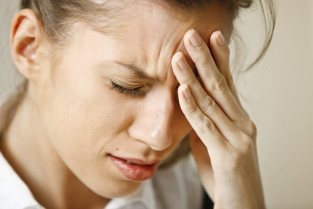
Various factors cause venous dilation. They can be conditionally divided into major and minor. The main sources of varicose veins are:
- Intense and constant physical activity;
- Extended stay in a static position - sitting or standing;
- Adverse environmental conditions - for example, constantly high air temperature;
- Fluctuations in body weight or chronic obesity;
- Hormonal imbalance - during pregnancy or menopause;
- Diseases of the endocrine system;
- Hereditary and genetic predisposition, manifested in the features of the structure of blood vessels, namely, congenital anatomical inferiority of venous valves and weakness of connective tissue of arterial walls;
- Neuroses.
In the anamnesis, the development of varicose veins, as a rule, stimulates not one, but a complex of factors.
Tips for everyday life
If you are constantly sitting, for example because of work, you can put a low bench under your feet. This way you will significantly reduce the strain on your legs.
It is advisable to forgo high heels. Wearing such shoes will greatly limit the contraction of the calf muscles, in addition, it will prevent the joints from bouncing. As a result, the blood will simply stagnate.
A sudden change in temperature can greatly affect the filling of the veins with blood. For example, when the temperature rises, the veins are very filled with blood, thus increasing the load on the valves. It is advisable to reduce the number of hot baths, sunbathing on the beach, etc. Remember that the temperature drop must be gradual.
Biking, swimming, and of course daily brisk walking are very helpful. It is good to remember that when walking you should give your preference to shallow water or sand and avoid difficult roads as much as possible. A two-minute contrasting leg soak will help you easily get rid of the feeling of heaviness and numbness. In addition, this watering can be done using a shower.
Remember that when you cross your legs, you obstruct the blood flow and constrict the blood vessels.
At rest, position your feet so that they are level with your heart. You can also raise one side of the bed slightly so that your legs are slightly higher than usual.
Symptoms of the disease
Varicose veins can have various manifestations, which depend on the degree of complexity of the pathology and the physiological characteristics of the patient's body. Depending on the stages of varicose veins, the following symptoms of vascular disease are noted:
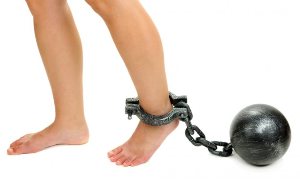
- Venous patterns or "stars" (telangiectasias) on the skin;
- Swelling of the limbs, especially at the end of the day;
- Pain in the legs or along the veins when probing them;
- Recurrent crises;
- Rapid fatigue, especially when walking;
- Visual manifestation of veins on the surface of the skin;
- feeling of heaviness in the legs;
- Burning in venous lesions;
- Muscle itching;
- Different types of pain and stiffness;
- Sinuous veins in legs and feet;
- Dermatological changes in the skin - appearance of dryness, pigmentation, darkening;
- Development of dermatitis, eczema and trophic disorders in the form of non-healing wounds and ulcers;
- Skin tightening at sites of varicose vein progression;
- Hematoma formation.
Symptoms can start in adolescence. Developing imperceptibly, after some time the disease makes itself felt with a mass of unpleasant health consequences. If at least one of the above signs is present, you should have an examination immediately. A phlebologist or surgeon treats diseased veins.
Classification
Based on the decision of the international scientific community, pathological dilation of the veins of the lower extremities is usually classified according to a special CEAP or Clinical Etiology Anatomy Pathology classifier. Based on this typology, varicose veins have 6 clinical stages:
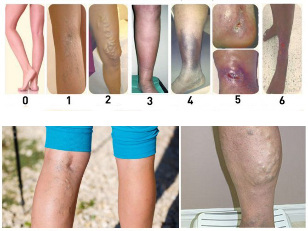
- Zero. There are minor subjective complaints from the patient about some of the symptoms of varicose veins, but with a visual examination and medical examination, there are still no obvious signs of the disease.
- I degree. On the surface of the skin appear small vascular networks, rare edema, heaviness, burning, sensation of "buzzing" in the legs.
- Grade II. It is considered to be the starting point for true varicose veins. It is characterized by a distinct external manifestation of dilated vessels, the formation of venous nodes, aggravated after a long stay in a static state or walking in high heels. From this stage, the possibility of thrombus formation is observed.
- III degree. Symptoms of the second group are accompanied by regular swelling, most noticeable at the end of the day, and a aching, aching pain in the calves.
- degree IV. There are trophic changes in the skin. Due to the excessive accumulation of pigment in the epidermis, the skin begins to change color from dark brown to black. It is also possible to develop small local inflammations in the form of erythema or wet sores, leading over time to skin atrophy and ulcers.
- Grade V. Trails the same as Stage 5, but with a healed trophic ulceration.
- Grade VI. It is characterized by severe progression with the formation of non-healing wounds and ulcers.
Varicose veins are a serious disease. Without timely treatment and constant prophylaxis, it progresses rapidly and leads to irreversible and disastrous consequences, which can lead to death. Only ten years after the diagnosis of varicose veins is enough for the pathology of stage I to develop into VI.
Steps
The first signs of varicose veins on the legs appear in progressive stages, when the venous valves are less than 50% functional. In the first or zero stage of varicose veins, known as the "clearing stage", unpleasant sensations do not occur, as well as visible changes. Detection of the initial stage of varicose veins on the legs occurs with careful examination of the limbs by a phlebologist.
In the second stage of varicose veins, which is known as "undercompensation", the changes are expressed quite well:
- large veins are visible under the skin, but they may not protrude above the surface of the skin;
- on the surface of the skin on the thighs and below the knees, a pattern of a thin varicose mesh of capillaries of blue or red color is clearly visible;
- the legs become swollen in the evening;
- calf muscle cramps at night.
This stage of varicose veins of the lower extremities is distinguished by an increase in symptoms, which weaken after rest.
In the final stage of varicose veins, decompensation occurs: the body cannot replenish the oxygen needs of the tissues, and the valves in the veins lose their function by 90%. The condition of the limbs worsens due to insufficient blood supply. This stage of varicose veins is characterized by a decrease in the ability of tissues to regenerate. The abundance of complications worsens the general condition of the patient. The final stage symptoms of varicose veins persist constantly.
Pathology in humans
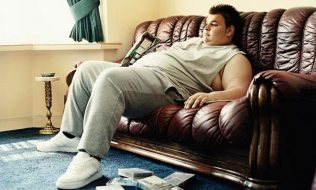
Venous pathology has no gender. However, depending on the pathogenesis, the disease is classically divided into male and female varicose veins, each of which is inherent in its own specificity of formation and development. Thus, the features of male physiology do not contribute to the formation of problems with the veins in representatives of the strong half of humanity, however, a number of factors favor this. Among them:
- Strenuous physical work or professional sports involving carrying or lifting a load;
- Sedentary lifestyle;
- Poor nutrition;
- Genetic propensity;
- Long-term use of hormonal drugs;
- Bad habits.
Varicose veins develop more often in men after the age of 40 and are accompanied by increased fatigue in the legs, pain in the legs, visible edema, venous pattern at theskin surface, frequent cramping and itchy skin such as allergic dermatitis. In some advanced cases, blood clots and vascular infection are possible. And if at first the disease is invisible, its manifestations become evident over time. But the main changes take place inside the veins, whose walls are so weakened that any exposure, even minor, to a toxic substance or an infection causes their damage. The method of treating varicose veins in men is the same as in women and has no special features.
Pathology in women
The beautiful half of the population suffers from varicose veins several times more often than men. The favorable factors for this are:
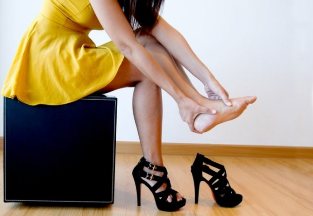
- Wear high heel shoes or shoes that do not match the size and fullness of their feet;
- Slimming or tight clothing that interferes with normal blood circulation;
- Work that requires standing all day - salesman, receptionist, hairdresser, teacher, cook, etc.
- Hormonal changes due to pregnancy, childbirth and age-related changes in the body (menopause);
- Experiments with weight - frequent fluctuations in body weight, extreme diets aimed at dramatic weight loss, uncontrolled set of extra pounds.
It is women who are frequent patients of phlebologists and cosmetologists. In an effort to preserve the aesthetic appearance of the skin as long as possible, women are more responsible for treating varicose veins than men, and they achieve visible improvements in the clinical condition of the arterial system.
Considering the increased natural tendency to varicose veins, the appearance of symptoms such as swelling of the legs, excessive fatigue of the legs, itching and burning sensation, the manifestation of small vessels and a venous pattern should seriously alert awoman and become a reason for an immediate visit to the doctor.
Treatment of varicose veins with folk remedies
When studying the presented disease, one should not panic, because with proper and timely treatment varicose veins are practically cured.
Why practically? Because after the end of certain actions, including preventive methods, the disease can reappear and cause no less problems than it originally was.
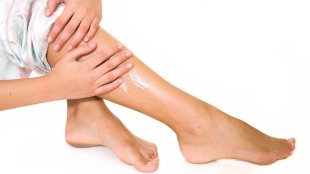
How to treat varicose veinsquickly and painlessly? You should turn to traditional medicine.
Infusions and tinctures
First of all, the disease must be treated from the inside. To do this, you need to prepare infusions or tinctures with the help of natural products, herbs and other ingredients that will improve blood circulation. Some of them can be cured here:
- Nettle. Pre-dry and grind the grass in any convenient way. To prepare the infusion, 2 tablespoons of the herbal component is poured with a glass of boiling water. The contents are kept for one hour and filtered. Then they drink ¼ glass during the day at least 3 times. The course of treatment lasts six months with intervals of one month.
- Horse chestnut. The grains of crushed horse chestnuts are placed in a three-liter jar halfway and poured over the edges of the container with vodka or alcohol. Within a month, the jar is stored in a dark place, periodically shaking the contents. After the time has passed, you can start rubbing the legs with the resulting tincture. Do such procedures 2-3 times a week without interruption.
Treatment of varicose veins at home with folk remedies involves the use of all herbal remedies that can improve blood circulation in the human body.
Apples for varicose veins
Apples have an excellent healing effect. Here you can use the fruits in their pure form and as additives to other products.
How to get rid of varicose veins with apples:
- Prepare the apple infusion. To do this, soak the apples in hot water at the rate of 1 liter for 4 hours. Then pass the fruits through a meat grinder or sieve, mix them with the water in which the soaking was carried out. Squeeze out the water from the mixture and take it twice a day at the rate of 50 g. The
- apple cider vinegar for varicose veinscan be used as a rub or inside. For treatment, it is sufficient to rub a small amount of vinegar on the problem areas overnight. You can also use vinegar diluted with a little honey, having a glass before meals half an hour before meals.
Be careful when using diluted vinegar internally. This method is prohibited for people suffering from gastrointestinal diseases.
Treatment of varicose veins at home, video:
Diagnosis of diseases
To make an accurate diagnosis of varicose veins, as well as to determine the degree of its severity, special research methods are used. The standard examination scheme for contacting a phlebologist includes the following procedures:
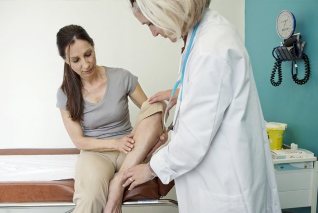
- Collect a history of the disease, which determines the risk factors and possible causes;
- Visual examination of the patient by changing the last position, as well as palpation of venous lesions;
- Laboratory blood test;
- Color duplex ultrasound ultrasound of the arteries of the lower extremities, which allows to properly conduct medical advice, measure the speed and direction of blood flow, map its movement, obtain a characteristic and clear picture ofblood vessels;
- Vascular x-ray (venography) using a contrast agent to determine the appearance and shape of the veins, the functionality of valves and the direction of blood flow.
Often these research methods are more than enough to determine the exact clinic, but in some cases they involve additional diagnostic methods:
- 3D CT (computed tomography) with venography;
- Photoplethysmography, using infrared and light radiation from a photoresistor or phototransistor;
- Phleboscintigraphy, based on the use of radionuclide isotopes, and phlebomanometry, dynamic study of the venous pressure of the lower limbs;
- Lymphoscintigraphy, showing the condition and degree of modification of the lymph nodes.
The need for a particular diagnostic method is determined by the doctor, depending on the complexity of the situation and the individual clinical parameters of the patient.
A timely and well-chosen method of research makes it possible to determine the position of the superficial and deep veins and to form an exact scheme of the therapeutic course according to the indicators.
Conservative treatment
In the early stages, varicose veins are reversible and with a responsible approach to treatment they are completely eliminated. In other cases, to combat varicose veins, they resort to conservative treatment using drugs, intravenous correctors and special compression underwear. Each of this type of treatment has its own indications for the appointment and the specifics of the impact on the diseased organ.
- Drug therapy. This involves the oral use for a certain period of phlebotropic drugs - phlebotonics, anticoagulants and antioxidants - which help to strengthen the blood vessels and reduce their fragility, to better thin the blood and normalize the blood circulation, and to eliminatetoxic substances accumulated from the body. For local treatment, tonic, analgesic, soothing and bulking gels and ointments are used. In addition, vitamins of groups B, A, K, etc. are introduced into the therapeutic complex. The decision on the duration of treatment is made depending on the results of the diagnosis and the nature of the dynamics of the disease.
- Arterial sclerotherapy. The method involves the use of special drugs acting by the type of sticking of the vein affected by varicose veins from the inside. As a result, the reflux is stabilized and carried out through healthy vessels. The procedure is performed invasively by intravenous administration of a solution. It is prescribed for a certain condition of blood vessels and small sizes of venous nodes.
- Ozone therapy. It is part of cosmetic medicine and involves exposing the interior space of the vessel to cold ozone in order to glue the site of the defect. In addition, the method is actively used to remove unsightly vascular networks from the surface of the skin. Effective at the initial stage of the disease. To achieve the desired result, a few procedures are enough.
- Compression therapy. It involves wearing special medical underwear that creates pressure of varying intensity on different parts of the legs, which in turn helps reduce the load on the veins and restore blood circulation. The constant use of corrective underwear protects the blood vessels from stretching and the development of thrombosis. Depending on the purpose, the compression underwear is prophylactic (minimum compressive force), therapeutic (worn only during exacerbation of venous disease) and hospital (used in the postoperative period in the hospital). Available in tights, stockings, knee-highs and elastic bandage. The choice of compression underwear is carried out only on the recommendation of a doctor
Surgical methods to influence dilated veins
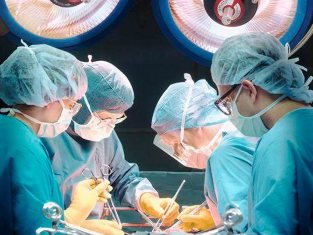
Operation for varicose veins is only performed as a last resort, when a deep lesion of the veins is diagnosed, aggravated by concomitant complications. Indications for the appointment of surgical intervention are:
- Noticeable worsening of the pathology;
- Development of thrombophlebitis;
- Visible increase in saphenous veins;
- Severe swelling and fatigue of the lower limbs;
- Pathological reflux disorder.
The operation is performed under general anesthesia using modern surgical techniques, such as:
- Radiofrequency obliteration of blood vessels. Restoration of the venous structure from the inside using disposable catheters and automatic radio wave generators.
- Endovenous Thermal Vapor Pulse Occlusion (SVS). Impact on the tanks of an abundant flow of heated steam. Allows to penetrate into the most inaccessible areas of the venous bed and directly influence the deformed vessels.
- Laser coagulation of the veins. It involves the use of a laser beam directed towards the diseased vein. The procedure leaves no cuts, burns or scars.
- Venaseal Technique. It consists of gluing the valves of the containers with a special biological glue.
- Varadi method. The most difficult method of treatment, involving the removal of the affected vessel. Due to its 100% effectiveness, it is one of the priority methods of neurosurgery.
Despite the great efficacy of surgical treatment, it is often combined with conservative therapeutic methods. This approach allows you to speed up the healing process and reliably consolidate the result.
Self-massage of the legs from varicose veins
- You need to massage your thighs first. Also, with light stroking and kneading, work your way up from the knee area to the groin area. Using a spiral, straight, circular motion, stretch the knee joint with your fingertips. Press your fist on the popliteal fossa several times and knead this area in circular motions.
- Lie on your back, relax your muscles and bend your knees. Grasp the shins with your hands and rub the skin with movements. Shake the muscles in your legs.
- Stretch each toe with light movements. From bottom to top, rub the ankle and both feet. Massage your feet and heels in a circular motion, and with a little force, rub your ankle.
Repeat this entire self-massage complex 2-3 times.
Rehabilitation period
During the recovery period and in the future, in the fight against varicose veins of the lower extremities, a competent rehabilitation program, including periodic drug therapy, as well as observing the rules of a healthy lifestyle andimplementation of therapeutic exercises, help.
In addition to the physical education of the sanatorium, a patient diagnosed with varicose veins, regardless of the stage of development and the period of rehabilitation, to improve blood circulation and prevent stagnation of blood in the veins, it isuseful to wear corrective medical underwear.
Nutrition for varicose veins of the lower limbs
Diet is very important in this disease. The following food products must be present in the diet:
- pepper;
- carrots;
- white cabbage;
- citrus;
- apples;
- nuts;
- rosehip;
- currant;
- sea fish;
- eggs;
- lean meat;
- legumes
- cereals; cheese
- ;
- liver.
The diet for varicose veins of the lower extremities involves the rejection of these products:
- canned food;
- semi-finished products;
- muffins and pastries;
- caffeinated drinks;
- smoked meats;
- pickled foods;
- meat in jelly;
- chicory;
- alcoholic beverages.
Prevention
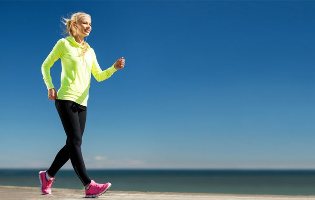
In order to prevent the development of varicose veins of the lower extremities, it is necessary to monitor your health from an early age. Prevention of the disease is more effective than treating the legs in case of complications.
In order to have good blood circulation, it is necessary to ensure sufficient physical activity. If a person at work stays in one position for a long time, then you need to regularly warm up a little. It is necessary to take a responsible approach to the choice of shoes - it should be with a small heel (not higher than 6 cm), comfortable, not to tighten the leg.
The weight should be monitored. One of the predisposing factors for the development of the disease is excessive weight. In addition, it leads to increased stress on the blood vessels. Clothing should be made from natural fabrics. The use of underwear that is too tight should be avoided in order to avoid tightening the large vessels in the groin area.
During hygienic procedures, it is advisable to use a shower, which allows the water pressure and temperature to be changed. With the help of these tricks, you can tone blood vessels, activate blood circulation.
It is advisable to exercise or exercise daily. You don't have to run several kilometers at a time, just visit the pool, walk or cycle for fun.
Before using hormonal contraceptives, you should consult not only a gynecologist, but also a phlebologist, to get tested for hormones. If you change the level of female hormones in the blood, it can adversely affect the condition of the walls of the vessels.












































